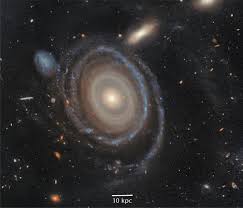Bullseye Galaxy : Recently Discovered

The Bullseye Galaxy (LEDA 1313424) was recently discovered by an international team of researchers using the Hubble Space Telescope and W.M. Keck Observatory.
- The galaxy’s distinct ringed structure is believed to have formed approximately 50 million years ago due to a head-on collision with a blue dwarf galaxy.
- This head-on collision is believed to have caused rippling gas waves, leading to star formation in ring-like patterns.
- This discovery was termed “serendipitous” as ringed galaxies usually have only two or three rings.
- Observed Through Multiple Telescopes:
- The Hubble Space Telescope confirmed eight rings.
- The M. Keck Observatory in Hawaii confirmed a ninth ring, revealing the full structure.
- The Bullseye Galaxy spans 250,000 light-years in diameter — nearly 5 times larger than the Milky Way. Despite a current separation of 130,000 light-years, a thin trail of gas still connects it to the colliding dwarf galaxy.
- The Bullseye may evolve into a Giant Low Surface Brightness (GLSB) Galaxy, a rare, massive galaxy type believed to hold clues about dark matter.
- Giant Low Surface Brightness (GLSB) Galaxy features:
- Composed of diffuse, low-density stellar disks.
- Contain large amounts of neutral hydrogen but exhibit low star formation rates.
- Include examples like Malin 1, which is 5 times wider than the Milky Way.
- GLSB galaxies are believed to be rich in dark matter, and their unusual mass distribution challenges the Standard Model of Cosmology.
- These galaxies display a uniform central mass instead of a dense core, suggesting discrepancies in current models.




